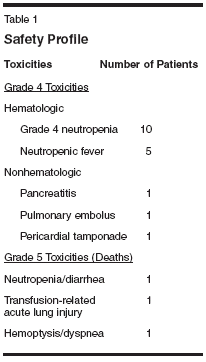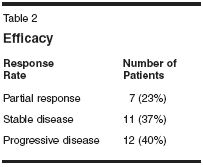Irinotecan and Carboplatin in Metastatic or Recurrent NSCLC: An Update
The 1-year survival for patients with metastatic non–small-cell lungcancer is only around 35%. We are evaluating the combination ofirinotecan (Camptosar) and carboplatin (Paraplatin) in patients withstage IIIB and IV non–small-cell lung cancer. The first five patientsreceived irinotecan, 250 mg/m2 over 90 minutes followed by carboplatinat an area under the concentration-time curve of 5 over 1 hour. Thedose of irinotecan was subsequently reduced to 200 mg/m2 in view offebrile neutropenia in one of five patients. Chemotherapy cycles arerepeated every 21 days. Patients are reevaluated every two cycles. Of aplanned 42 patients, 37 have been enrolled so far. Of the 37 enrolledpatients, 25 received at least two cycles, 20 received at least four cycles,and 12 received all six planned cycles. Grade 4 neutropenia (absoluteneutrophil count < 500) occurred in 10 patients and 19 treatment cycles.Two of these patients also had grade 4 diarrhea. Thirty-six cycles (30%)were delayed for neutropenia, six of which occurred among the firstfive patients who received irinotecan at 250 mg/m2. Best response totherapy included 7 partial responses (23%), 11 stable disease (37%),with 12 patients having progressive disease (40%). The regimen ofirinotecan and carboplatin administered once every 3 weeks is tolerableand convenient, with early evidence of activity. The main toxicityis hematologic. This study is ongoing and actively accruing patients.
The 1-year survival for patients with metastatic non–small-cell lung cancer is only around 35%. We are evaluating the combination of irinotecan (Camptosar) and carboplatin (Paraplatin) in patients with stage IIIB and IV non–small-cell lung cancer. The first five patients received irinotecan, 250 mg/m2 over 90 minutes followed by carboplatin at an area under the concentration-time curve of 5 over 1 hour. The dose of irinotecan was subsequently reduced to 200 mg/m2 in view of febrile neutropenia in one of five patients. Chemotherapy cycles are repeated every 21 days. Patients are reevaluated every two cycles. Of a planned 42 patients, 37 have been enrolled so far. Of the 37 enrolled patients, 25 received at least two cycles, 20 received at least four cycles, and 12 received all six planned cycles. Grade 4 neutropenia (absolute neutrophil count < 500) occurred in 10 patients and 19 treatment cycles. Two of these patients also had grade 4 diarrhea. Thirty-six cycles (30%) were delayed for neutropenia, six of which occurred among the first five patients who received irinotecan at 250 mg/m2. Best response to therapy included 7 partial responses (23%), 11 stable disease (37%), with 12 patients having progressive disease (40%). The regimen of irinotecan and carboplatin administered once every 3 weeks is tolerable and convenient, with early evidence of activity. The main toxicity is hematologic. This study is ongoing and actively accruing patients.
Lung cancer is the most common cancer in the United States, and the most common cause of cancer death for both men and women. Non-small-cell lung cancer (NSCLC) accounts for 84% of all lung cancer diagnoses, with nearly 60% of patients presenting with unresectable or metastatic disease.[1] The incorporation of newer chemotherapeutic agents into treatment regimens has improved survival as compared to those used in earlier decades, but survival has reached a plateau with currently available drugs. Further improvements in survival for these patients will require continuing investigations of novel treatment regimens. Irinotecan (Camptosar) is a camptothecin- derived chemotherapeutic which is being used to treat an increasing variety of cancers. In metastatic colon cancers, the addition of irinotecan to fluorouracil (5-FU) resulted in a survival advantage compared to 5-FU alone, resulting in US Food and Drug Administration approval of irinotecan for this indication.[ 2] A study of small-cell lung cancer comparing standard treatment with cisplatin and etoposide to cisplatin and irinotecan also found irinotecan to confer a survival advantage for the irinotecan-treated group.[3] There have been several small phase II studies combining cisplatin with irinotecan for stage IIIB and IV NSCLC. These studies report response rates of approximately 45% with an average 1-year survival rate of 46%- results that compare favorably with other modern two-drug combinations.[ 4] Two phase III studies have been reported from Japan in which cisplatin and irinotecan were compared to a standard NSCLC regimen of cisplatin with vindesine (Eldisine).[5,6] Both studies used a combination of cisplatin at 80 mg/m2 every 3 weeks together with irinotecan at 60 mg/m2 on days 1, 8, and 15. These two studies reported encouraging response rates for cisplatin and irinotecan (29% for Niho et al vs 43% for Negoro et al). Median survival was comparable (45.4 vs 50 weeks) and did not differ significantly from the survival of patients treated with cisplatin plus vindesine, although subgroup analysis performed by Negoro et al suggested a superior survival for stage IV patients treated with irinotecan.


Carboplatin (Paraplatin) is frequently substituted for cisplatin for the treatment of lung cancer patients in the United States because of its convenience and ease of tolerability. This prompted studies combining carboplatin and irinotecan for patients with NSCLC. Takeda et al reported a phase II study in which 36 patients with stage IIIB or IV NSCLC received carboplatin at an area under the concentration- time curve (AUC) of 5 combined with irinotecan at 50 mg/m2 on days 1, 8, and 15.[7] The reported response rate was 25%, with a median survival of 10.2 months. The authors noted that the increased myelosuppression attributable to carboplatin made it difficult to give the day 15 irinotecan dose, which was omitted more than half of the time. While weekly administration of irinotecan has been studied extensively, irinotecan can also be administered every 3 weeks. Cardenal et al reported a phase II study in which 74 NSCLC patients received cisplatin at 80 mg/m2 and irinotecan at 200 mg/m2 every 3 weeks.[8] The reported response rate was 34.2% with a 1-year survival of 31%, similar to results reported for other regimens used in this disease. We are conducting a phase II study of irinotecan and carboplatin administered once every 3 weeks in patients with advanced NSCLC, and have reported the preliminary results of this study previously. This report summarizes the toxicity and efficacy data on 37 patients. Materials and Methods The primary objective of this study was to determine the response rate in patients with stage IIIB or IV NSCLC treated with the combination of carboplatin and irinotecan administered every 3 weeks. Secondary objectives included characterization of toxicities and determination of 1-year survival. In addition, pharmacogenomic data were obtained to study correlate gene polymorphisms that are associated with altered irinotecan metabolism with toxicity and response. Eligible patients had metastatic (stage IV) or stage IIIB (those with pleural effusion) NSCLC who had not received prior chemotherapy for NSCLC. Patients were to have had a Zubrod performance status of 0 or 1, and adequate bone marrow, liver, and renal func- tions. Patients requiring anticonvulsant treatment with phenytoin or carbamazepine (Tegretol) were excluded because of the known interaction between anticonvulsants and irinotecan. All patients received carboplatin at an AUC of 5. The first five patients received irinotecan at a dose of 250 mg/m2, but in light of frequent dose delays for neutropenia, the dose of irinotecan was changed to 200 mg/m2. Chemotherapy was administered every 3 weeks. Patients underwent a complete blood count (CBC) every week while on treatment, and CBC with metabolic tests every 3 weeks before treatment. Patients underwent assessment of measurable disease sites with computed tomography scan every two cycles or as clinically warranted. Patients with response or stable disease could receive up to six cycles of treatment on study. Results To date, 129 cycles of chemotherapy have been administered to 37 patients. Twenty-five patients received at least two cycles, 20 received at least four cycles, and 12 received all six planned cycles. Three deaths occurred on study (within 30 days of receiving chemotherapy). One death, due to neutropenic sepsis and diarrhea, was treatment-related, and the other two were considered to be unrelated (one patient had disease progression and one had transfusion-related acute lung injury). All deaths on study occurred after the first cycle. Grade 4 neutropenia (absolute neutrophil count < 500) occurred in 10 patients and 19 treatment cycles. Two of these patients also reported grade 4 diarrhea (see Table 1). Thirty-six cycles (30%) were delayed for neutropenia, six of which occurred among the first five patients who received irinotecan at 250 mg/m2. The rate of severe neutropenia was 27%, including data from the patient who died.
Disclosures:
Dr. Govindan has received research support and honoraria for speaking engagements from Pfizer.
References:
1. Page N, Read W, Tierney R, et al: The epidemiology of small cell lung cancer (abstract 1216). Proc Am Soc Clin Oncol 21:305a, 2002.
2. Saltz LB, Cox JV, Blanke C, et al: Irinotecan plus fluorouracil and leucovorin for metastatic colorectal cancer. Irinotecan Study Group. N Engl J Med 343:905-914, 2000.
3. Noda K, Nishiwaki Y, Kawahara M, et al: Irinotecan plus cisplatin compared with etoposide plus cisplatin for extensive small-cell lung cancer. N Engl J Med 346:85-91, 2002.
4. Bunn PA, Jr: Irinotecan and platinums in the treatment of non small-cell lung cancer. Clin Lung Cancer 2(suppl 2):S14-S19, 2001.
5. Negoro S, Masuda N, Takada Y, et al: Randomised phase III trial of irinotecan combined with cisplatin for advanced non-smallcell lung cancer. Br J Cancer 88:335-341, 2003.
6. Niho S, Nagao K, Nishiwaki Y, et al: Randomized multicenter phase III trial of irinotecan and cisplatin versus CDDP and vindesine in patients with advanced non-small cell lung cancer (abstract). Proc Am Soc Clin Oncol 18:A1897, 1999.
7. Takeda K, Takifuji N, Uejima H, et al: Phase II study of irinotecan and carboplatin for advanced non-small cell lung cancer. Lung Cancer 38:303-308, 2002.
8. Cardenal F, Domine M, Massuti B, et al: Three-week schedule of irinotecan and cisplatin in advanced non-small cell lung cancer: A multicentre phase II study. Lung Cancer 39:201-207, 2003.